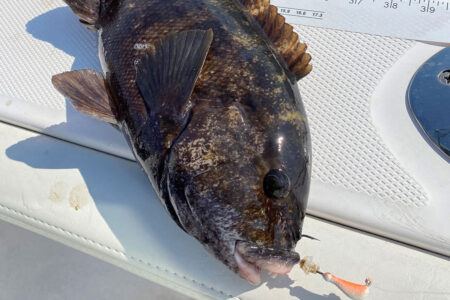Yep, this is another Editor’s Log about striped bass. What can I say? Striped bass have been, and will remain a hot topic due in no small part to the Atlantic States Marine Fisheries Commission’s (ASMFC) pending Benchmark Stock Assessment.
When the preliminary striped bass stock assessment data came out earlier this year, the first thing that jumped out at every armchair conservationist from Maine to Virginia and beyond was the note about the stock being overfished and that overfishing was occurring. To anyone who has been following along, this really shouldn’t have come as such a shock (Go back and read the piece by Bob Danielson in the March edition of The Fisherman Magazine for more details on this subject.). What was more surprising, to me anyway, was the information that exactly half of the 2017 coastwide harvest was due to dead discards by both the commercial and recreational fisheries! To be exact, the figures come in as follows:
2017 = 7,100,000 Fish Harvested
Recreational Dead Release = 48% (3,408,000 fish)
Recreational Harvest = 42% (2,982,000 fish)
Commercial Dead Release = 2% (142,000 fish)
Commercial Harvest = 8% (568,000 fish)
Right away, those who picked up on this point screamed that it was impossible. They said there is no way in heck that half of all fish “harvested” in 2017 could have been attributed to dead discards/release mortality (Keep in mind that in any management plan, release mortality is factored into the annual harvest as the deaths are attributed to angler interaction.). And I must admit, initially I was on their side. That is, until I sat back and started to really think about things. So how could this be possible?
For starters, there are probably more people targeting striped bass right now than at any other time in recorded history. Strike 1 against the striped bass. Attend a fishing show, peruse the internet or walk into a tackle shop and you’re going to encounter A LOT of passionate striped bass anglers. You simply do not see guys lining up overnight outside fishing flea markets to buy fluke rigs and tog jigs, but they do it to buy boutique striper plugs! I am not going to fault them. I mean, what else is there available to fish for at any given time in the season? With all the restrictions piling up on our other popular inshore species like blackfish, fluke, winter flounder, cod, haddock and the like, it is really no surprise that so many anglers have set their sights squarely on the striped bass?
Along with the popularity of striped bass seemingly at an all-time high, so is the conservation, catch-and-release mentality. Strike 2 against the striped bass as you’ll see. It has not only become generally unaccepted by the masses to beat one’s chest in front of a dead bass, accolades are given to those who document the release of the most and largest of fish. But this change in culture comes at a heavy price. By the nature of the act, when fish of any species are released, a given amount are expected to expire due to any number of factors including exhaustion, damage from the angling method and so-on. The ASMFC’s accepted release mortality—the number of fish which, on average, will die after being released—is set at 9%. While this is simply an estimate based upon release mortality studies, it is not that difficult of a number for me to accept across the entire population of striped bass anglers. While some of us practice proper fish-handling techniques, there are a great deal of fishermen across a wide scope of angling methods who do not. Take into account fish landed on snag and drop rigs; anglers running up 100-plus-fish counts in winter holdover rivers; fish landed in overly-warm summer waters off Block/Montauk by boat; that surf fisherman who drags his fish 30 feet up a sandy beach to unhook it; the same surf fisherman who kicks his fish back into the water from said 30-foot spot up the beach; the angler who uses bait off a pier and then lets the fish flop around on the pier in the noonday sun before unhooking and launching the fish back into the water and so-on. Even those of us who profess to be the voice of the conservation movement are not perfect, and I’ve witnessed a great many get caught up in the heat of a good bite or photo opportunity and inflict excessive harm on the fish they profess “swam away just fine.”
When we add the aforementioned strikes—more anglers targeting striped bass than ever and increased release practices—it is only logical that such a high percentage of the total coastwide harvest would be attributed to release mortality. We’ll call this “strike 3” against the striped bass and it is a major factor putting us at the place where we are now, and that is the fact that we are facing inevitable measures to reduce striped bass mortality coming in the 2020 season. How exactly this will be achieved is anyone’s guess, but we will have at least one possibility announced at the May meeting of the ASMFC as the striped bass Technical Committee was tasked with preparing a report to outline at least one set of proposed options that would allow the SSB to rebuild to the target level set in the latest Fishery Management Plan. I and the hordes of striped bass faithful up and down the coast eagerly await the report.
And one last thing before I receive a flood of hate mail over my seeming attack on catch and release practices here today, do not take my words as such. Instead I simply set out to shed some light on a subject that has come up in recent weeks and I feel many do not have a whole lot of information on which is readily available. While we all can agree that catch and release is a fine conservation method, the data presented by the ASMFC shows that by its nature, it too is not the end all be all to save a fish. That said, while a released striped bass may have a 91% of surviving the ordeal, one that ends up in your cooler has a 0% chance.



